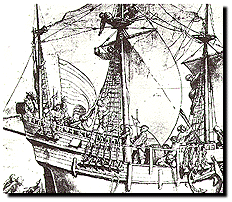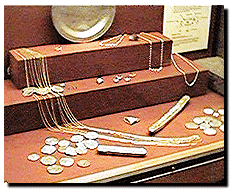Archaeology
Wreck formation
Once a ship wrecks it slowly starts to fall apart. You almost never find intact old ships on the seabed. As it collapses, objects spill over the seabed and sand or mud might pile up, buring it below the surface of the seabed. Over the years, exposed timbers rot away or are eaten by sea worms, so to the untrained eye there is little or nothing to show that the ship ever existed.
With wooden shipwrecks, the usual sign of a wreck site is a pile of the stones used to weigh the ship down or the cannons used to defend it. The archaeologist has to try to work out what the ship was from the remains on the seabed, which is not an easy job. A wreck is a form of giant puzzle, where the bits of the wreck site have to be understood before the archaeologist can work out much about what the ship was, where it came from or why it sank. Every object or surviving piece of ship might be the missing piece that will make sense of the puzzle.
This is a drawing of Santa Margarita, a Spanish galleon which wrecked off Florida in 1622.
Surveying Underwater
Once a wreck site has been found, archaeologists need to work out how big it is, and what it contains. For this they need to survey it. Once they have drawn a map of the site, then anything they find can be plotted onto it. This way they build up a picture of the wreck and keep a record of where everything came from.
Photography can help. If they take a series of overlapping photos of the seabed and lay them together, they can build up one big photograph of the whole wreck site. This is called a photo-mosaic.
To draw a plan you need to be able to measure. You can use grids, moving them over the site and measuring everything inside them. You can also take measurements from the object to several fixed points around the site. This is called triangulation. The accuracy of the final plan depends on the accuracy of these measurements, so archaeologists need to be as careful as possible, and archaeologists often use computers to help them.
Once a ship wrecks it slowly starts to fall apart. You almost never find intact old ships on the seabed. As it collapses, objects spill over the seabed and sand or mud might pile up, buring it below the surface of the seabed. Over the years, exposed timbers rot away or are eaten by sea worms, so to the untrained eye there is little or nothing to show that the ship ever existed.
With wooden shipwrecks, the usual sign of a wreck site is a pile of the stones used to weigh the ship down or the cannons used to defend it. The archaeologist has to try to work out what the ship was from the remains on the seabed, which is not an easy job. A wreck is a form of giant puzzle, where the bits of the wreck site have to be understood before the archaeologist can work out much about what the ship was, where it came from or why it sank. Every object or surviving piece of ship might be the missing piece that will make sense of the puzzle.
This is a drawing of Santa Margarita, a Spanish galleon which wrecked off Florida in 1622.
Surveying Underwater
Once a wreck site has been found, archaeologists need to work out how big it is, and what it contains. For this they need to survey it. Once they have drawn a map of the site, then anything they find can be plotted onto it. This way they build up a picture of the wreck and keep a record of where everything came from.
Photography can help. If they take a series of overlapping photos of the seabed and lay them together, they can build up one big photograph of the whole wreck site. This is called a photo-mosaic.
To draw a plan you need to be able to measure. You can use grids, moving them over the site and measuring everything inside them. You can also take measurements from the object to several fixed points around the site. This is called triangulation. The accuracy of the final plan depends on the accuracy of these measurements, so archaeologists need to be as careful as possible, and archaeologists often use computers to help them.
The thing that makes this archeology and not treasure-hunting or salvage is the scientific approach, which includes precision navigation and mapping. -
Brendan Foley



See Artifacts Recovered off the Jupiter Wreck
Measuring Underwater
Here is a replica of part of a wreck site. One of the main ways of plotting the position of objects is by using triangulation. Try it out for yourself.
Measure the distance from Point A to the red dot. Try to be as accurate as possible. Now do the same from at least two more points (B, C or D). Check your measurements against those taken by a professional underwater archaeologist. How well did you do? Are the measurements the same? They are? Then you've got what it takes to be an underwater archaeologist! If not, check the measurements again. Practice makes perfect!
The archaeologist would take these measurements and plot them on the map after scaling them down, using a pair of compasses. Say the measurement from Point A was 25 inches. If the map scale was 10:1, the compasses would be opened to 2.5 inches, the point put over Point A on the map and an arc would be drawn. The same would be done for all the other measurements. The object would be plotted where all the arcs crossed.
If you want, try out your new-found archaeological skill by measuring in the locations of other artifacts in the box.
Excavating Underwater
Excavating is destructive, so archaeologist needs to be careful and record all the information they can as they dig.
They use several excavating tools, including water dredges, airlifts, water jets and even buckets and spades! The best tool is the diver's own hand. By fanning the water over the seabed, water current removes the sand without damaging anything. Without sucking it out of the way, the sand would just fall back down again, so archaeologists use tools to take away the sand for them.
The water dredge is perhaps the most common underwater digging tool. High pressure water is pumped down a hose and into the dredge, which creating a suction effect, just like a vacuum cleaner! It works well both in shallow and deep water, while another tool, the airlift works best if the water is at least 20 feet deep.
Instead of water, it pumps air into the bottom of a long pipe. This makes the airlift suck up water, just like the water dredge, but it is more powerful. If the water dredge acts like a household vacuum cleaner, then the airlift resembles an industrial sized cleaner.
Here is a replica of part of a wreck site. One of the main ways of plotting the position of objects is by using triangulation. Try it out for yourself.
Measure the distance from Point A to the red dot. Try to be as accurate as possible. Now do the same from at least two more points (B, C or D). Check your measurements against those taken by a professional underwater archaeologist. How well did you do? Are the measurements the same? They are? Then you've got what it takes to be an underwater archaeologist! If not, check the measurements again. Practice makes perfect!
The archaeologist would take these measurements and plot them on the map after scaling them down, using a pair of compasses. Say the measurement from Point A was 25 inches. If the map scale was 10:1, the compasses would be opened to 2.5 inches, the point put over Point A on the map and an arc would be drawn. The same would be done for all the other measurements. The object would be plotted where all the arcs crossed.
If you want, try out your new-found archaeological skill by measuring in the locations of other artifacts in the box.
Excavating Underwater
Excavating is destructive, so archaeologist needs to be careful and record all the information they can as they dig.
They use several excavating tools, including water dredges, airlifts, water jets and even buckets and spades! The best tool is the diver's own hand. By fanning the water over the seabed, water current removes the sand without damaging anything. Without sucking it out of the way, the sand would just fall back down again, so archaeologists use tools to take away the sand for them.
The water dredge is perhaps the most common underwater digging tool. High pressure water is pumped down a hose and into the dredge, which creating a suction effect, just like a vacuum cleaner! It works well both in shallow and deep water, while another tool, the airlift works best if the water is at least 20 feet deep.
Instead of water, it pumps air into the bottom of a long pipe. This makes the airlift suck up water, just like the water dredge, but it is more powerful. If the water dredge acts like a household vacuum cleaner, then the airlift resembles an industrial sized cleaner.
- information supplied by the Miami Museum of Science.